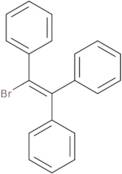2-Bromo-1,1,2-triphenylethylene
CAS : 1607-57-4
Ref. 3D-BAA60757
| 10g | Arrêté | ||
| 25g | Arrêté | ||
| 50g | Arrêté | ||
| 100g | Arrêté | ||
| 250g | Arrêté |
Informations sur le produit
- (1-Bromo-2,2-diphenylethenyl)benzene
- 1,1',1''-(2-Bromoethene-1,1,2-Triyl)Tribenzene
- 1,1′,1′′-(1-Bromo-1-ethenyl-2-ylidene)tris[benzene]
- 1,1′,1′′-(2-Bromoethene-1,1,2-triyl)tribenzene
- 1,2,2-Triphenylvinyl bromide
- 1-Bromo-1,2,2-triphenylethene
- 1-Bromo-1,2,2-triphenylethylene
- 1-Bromotriphenylethylene
- 2-Bromo-1,1,2-Triphenylethylene
- 2-Bromo-1,1,2-triphenylethene
- Voir d'autres synonymes
- Alpha’-Bromo-Alpha-Phenyl-Stilben
- Aurora Ka-6594
- Benzene, 1,1,1-(1-bromo-1-ethenyl-2-ylidene)tris-
- Bromotriphenyl-Ethylen
- Bromotriphenylethene
- Eitriphin
- Ethylene, bromotriphenyl-
- NSC 38797
- Phenylstilbene Bromide
- Triphenylbromoethene
- Triphenylethenyl bromide
- Triphenylethylene bromide
- Triphenylvinyl Bromide
- À-Bromo-À'-Phenylstilbene
2-Bromo-1,1,2-triphenylethylene is a luminescent probe that emits light when it reacts with nitro groups. It has been used to detect the presence of nitrogen atoms in particle samples and can be used as a human serum marker for autoimmune diseases. 2-Bromo-1,1,2-triphenylethylene has also been used in Suzuki coupling reactions to form disulfide bonds between two proteins. The photochemical properties of this compound have been studied extensively and it has shown hydroxyl group reactivity. 2-Bromo-1,1,2-triphenylethylene also reacts with nucleophilic attack by water vapor or phenolic acids to form an intermediate carbonyl group.





